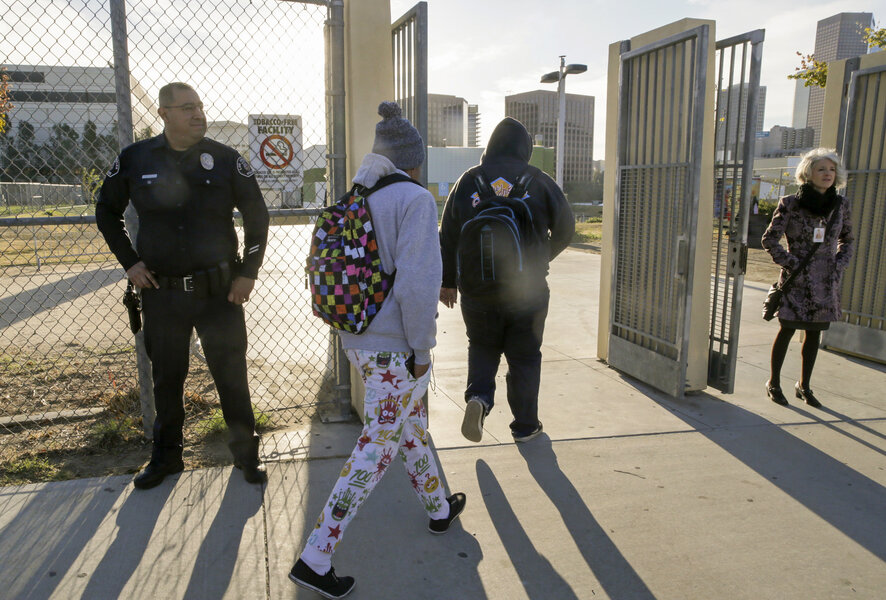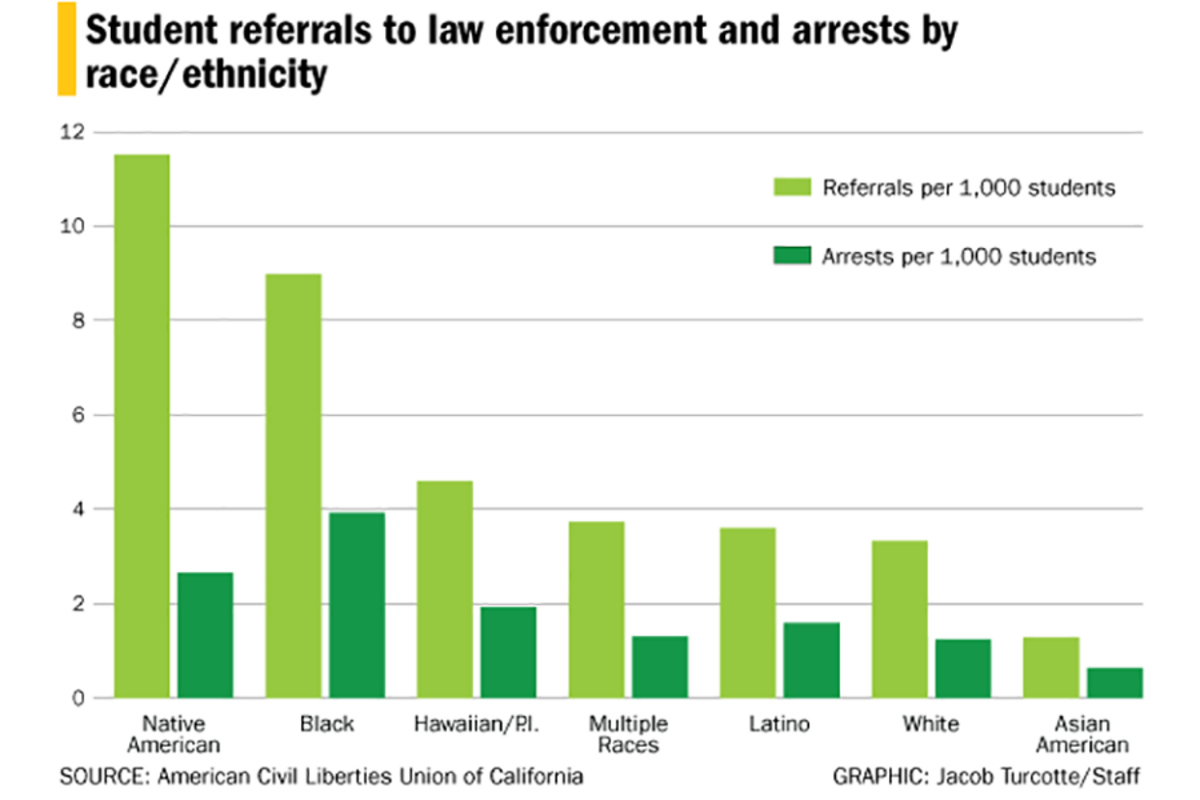Are teachers ceding too much discipline to in-school police officers?
Loading...
When a major disciplinary issue flares in their classroom, teachers often face a tough choice: Can I handle this myself – or do I need backup?
Over the past two decades, teachers have increasingly asked for reinforcement in the form of a school resource officer (SRO), a police officer specifically assigned to a school or district. Sometimes they respond to emergencies, like the presence of an active shooter. But more frequently, a new American Civil Liberties Union report shows, teachers are turning to police to handle something far more minor, such as a student who is disruptive but not physically threatening.
During the 2013-14 school year in California, more than 20,000 students – a majority of them low-income children of color or children with disabilities – were disciplined by school police for minor infractions that teachers would have handled in the past, the ACLU found. More than 9,500 of those interventions resulted in arrests; at their extreme, they involved strip searches, excessive use of force, and pepper spray.
The consequences of such discipline can be long-lasting. If a student is arrested in such an encounter, the likelihood they’ll end up dropping out of school or becoming entangled in the criminal justice system dramatically increases, according to the report, which recommends a reconsideration of how – or if – SROs are employed in schools.
“Especially in California … some districts are spending millions of dollars a year from classroom budgets to put armed police in schools,” says Linnea Nelson, education equity staff attorney for the ACLU’s Northern California branch and co-author of the report. “What we need to do is ensure schools can invest in resources that ensure a quality education for all students, like school counselors and mental health services that keep students in school.”
The ACLU based its report on recently released first-of-its-kind national data from the United States Department of Education Office for Civil Rights. Its findings, the group says, are relevant to all states and point to the need for more research nationwide.
The problem, attorneys say, stems from the fact that a majority of schools across the state have minimal, if any, guidelines for when a teacher can call on an SRO. An analysis of 119 school district policies across California, including its 50 most populous, found that between 57 percent and 68 percent of school districts gave teachers complete discretion to request police backup for incidents that included breaking school rules, bullying or harassment, disruption, and vandalism.
Outsized impact
In 2011, Michael Davis, a 5-year-old black boy with a diagnosed disability, experienced the outsized power SROs sometimes wield. Stockton school officials asked a senior police officer to meet with Michael to “scare him straight,” the report says. When he would not calm down, Lt. Frank Gordo officer zip-tied his hands and feet and took him to a mental health facility. In 2015, Lt. Gordo was dismissed by the department after Michael's family settled with the district for $125,000.
The excessive use of SROs corresponds with the steep growth of their presence across the nation. In 1975, only 1 percent of US schools had police officers. By 1997 that number had jumped to 22 percent, and in 2013-14, 24 percent of elementary schools and 42 percent of high schools nationwide had one or more full-time police officers.
What is indisputable, Ms. Nelson says, is that students of color face much greater disciplinary consequences than their white peers. Black students are three times as likely as white students to be subjected to in-school arrest, as are students with disabilities. The average arrest rate in schools where 80 percent or more students are low-income is seven times higher than in schools where 20 percent or less are.
Such encounters can have devastating short- and long-term effects, advocates say.
In one instance, a mom says her middle-school daughter’s grades plummeted after a male officer watched while a school administrator forced her to remove her bra during a strip search, and would not let her cover herself. When students are arrested, the likelihood they’ll drop out of high school doubles. If they have to appear in court, that statistic doubles again, according to the report.
Public alarm over such trends has already sparked some changes. In 2009-2010, the US Department of Education’s Office for Civil Rights began collecting data on student-police interactions. In January 2017, a new California law will demand that police keep comprehensive records of all stops and detentions.
For Nelson, next steps should include adopting ACLU recommendations, such as ensuring that teachers call police only when there is a serious threat. Also, rerouting funds for more counselors and mental health services, and training to help teachers resolve conflicts in a way that keeps students in school.
But, she adds, the key question is: "Are the people in the school districts really committed to implementing that vision?"
Contacted after the release of the report, Sgt. Julie Spry, public information officer for the Los Angeles School Police Department, said they need more time to read the report before commenting.







